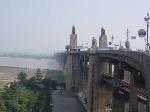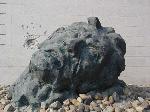- Getting around Lijiang. Dont stay in the Old Towns more than 2 days, there is nothing to do. KRISS Oct 9, 2013 05:46
- 2013 Beijing Temple Fair BENNYLAU Feb 26, 2013 03:29
- Malaysian traveling from KUL - LAX vis Shanghai PVG ZATI_DY Jan 3, 2013 20:15
Three Stories in Nanjing
- Views: 6298
- |Vote: 2 0
- |Add to Favorites
- |Recommend to Friends
The Great Bridge
It was the pride of the nation, and a feat of engineering that won a place in the Guinness Book of Records - the first Chinese-designed and Chinese-made bridge to span the great Yangtze River, and one of the most celebrated successes of the Chinese communist administration of its age. For me, however, it was the place where I was having a serious argument with my girlfriend.
Like all such arguments, it was about my mother, whom we were taking on a rapid tour of China, with all the associated pressures and irritations that would imply. It was hot, my mother was ill, and my sister urged my partner and I to go out and explore Nanjing on our own. Who knows why, but as soon as we reached the bridge, tempers flared and she rushed ahead alone. I sullenly followed at a distance.
The Yangtze River Bridge is gigantic, and it's little wonder that the morale of the entire country, three years into the Cultural Revolution, was greatly boosted by its completion, after promised Russian support was withdrawn in early stages of its construction. It was considered an architectural miracle at the time, the longest highway/rail bridge in the world, and as I wandered along its pedestrian lane wondering how to apologise without admitting guilt, even I was a little awed at its scale. It's an unusual looking structure, with lofty yellow towers at each end containing their own museums and elevators to the ground riverside level, and several bold statues of revolutionary workers and soldiers rising in resistance of Imperialism, invasion, natural obstructions, anything that might stand in their way. Since its construction, it has been the major overland pass across the great river until the last decade, when two new bridges at Nanjing eased the burden of ever-increasing traffic. Even now, however, the fond memory of the satisfaction the bridge once brought to the Chinese people draws thousands of visitors every year, who are still just as proud to walk over this historic monument to the unstoppable Chinese ability to overcome all things.
She was standing right in the centre of the bridge looking out over the river when I caught up with her. I didn't know what to say; there, on the walkway, I put my hand on her shoulder and followed her gaze. Old boats and huge cargo vessels passed far beneath, gliding silently on the silty water of China's greatest river.
"I've never seen it before", she said.
"I'm sorry?"
"Chang Jiang. The Yangtze River. This is the first time I've seen it."
We stood together and looked out over the water that had passed Sichuan and the great river port of Chongqing, followed the course through the massive Three Gorges and the great dam under construction at Yichang, passed over Hunan and was heading through Jiangsu across to Shanghai and the sea. The river is the lifeblood and the terror of Middle China; it floods and kills hundreds every year, and yet still nourishes the farmlands across the breadth of the country. No Chinese person can look at the Yangtze River without a sense of majesty and pride - and from the Nanjing Bridge, it is a view that carries with it the assurance that even the mighty Yangtze cannot break the will and intent of the Chinese people. Even I could feel it, and standing there looking out at the perilous waters atop something that seemed stronger, there didn't seem to be any reason to fight any more.
Yuejiang Tower
Nanjing had impressed us since we'd first arrived. Clean, spacious, well planned, it is one of China's greatest cities, and even recently was one of its capitals. The first night, we'd taken a bus to the centre of town and walked for hours through its wide, fascinating boulevards, passing the historic monuments, the city's drum tower and museums, the busy streets around the university bustling with life and enterprise.
Nanjing's an old-style city at heart, with the remains of its city wall quietly crumbling as the modern age just as quietly transforms its centre. There are vast areas set aside for sightseeing and relaxation, the Xuanwu Lake Park with its Ming Dynasty temple and towers and tranquil scenery; the nearby Hongshan Forest Zoo; the Zhongshan Scenic Area on Purple Gold Mountain with its numerous historic edifices and the Mausoleum of Doctor Sun Yat-Sen. It could be said that Nanjing offers days of fascinating sightseeing - but as we had just a couple of half days, we hadn't really the opportunity to indulge.
Our decision to climb Lion Mountain and visit the Yuejiang Tower was made almost at random. To be more exact, it stood magnificently in full view and within walking distance of our hotel, and seemed just as interesting as all the other attractions listed on our tourist map, which rather curiously had no mention of the tower. From a distance, with its brightly coloured stylised roofs and terraces, it seemed to be an excellently preserved ancient tower, and we made out early in the morning to climb it.
Lion Mountain stands in a park that overlooks a good section of the old city wall, and we wandered along its edge looking out at the river as we worked our way around the curving pathway to the top. Every time we caught sight of the tower at its summit, we were astonished by its colour and good condition. I guessed it had been recently restored, and when we reached the top, that did seem to be the case. Wandering through the complex, we found places where I guessed the Emperors of old would have sat, wrote, and gazed out over Nanjing as we did then.
I couldn't have been more wrong. I picked up a pamphlet discarded on a tabletop and took a quick look at the notes to find out when the tower had been built. I was confounded to discover that Yuejiang Tower was first completed in 1999, making it less than five years old.
I was furious - of all the ancient sites I could have chosen in Nanjing, I'd come to the only one that was a patent fake. As I read on, however, I began to reconsider. I discovered that the plans for the tower had been made out 500 years before, but for a number of reasons that were less than clear, the project had been indefinitely postponed. It was only in the last years of the 20th century that locals had decided to at last fulfil the intentions of their forebears and complete the tower.
The tower is still a testament to Chinese architecture and ingenuity. Despite having been fashioned with tools of the modern age, it was still faithful to classical design and, admittedly, made on Chinese territory by Chinese hands. Standing on the fulfilment of a 500 year old dream, I began to wonder if age is really an indicator of authenticity - and to remember that the greatest thing about China is that it is a continuous civilisation spanning the ages - making the achievements of this one just as glorious as those of days gone by.
Nanjing Massacre Museum
There are few more sobering stories of the War against Japanese Aggression than that of the Rape of Nanjing. In one of the most horrifying and brutal attacks of the entire Second World War, the invading Japanese forces committed such inhuman and criminal acts of violent rape and slaughter that for many years after the war and in some places even today, the details are doubted by historians and other members of the public.
The Nanjing Massacre Museum stands to record, demonstrate and prove the version of events as claimed by the Chinese is entirely true and correct. Photographs, records, even disfigured skeletons give their testimony without any censorship or exaggeration.
We couldn’t have lived with ourselves to have been in Nanjing without taking the chance to see the museum. Even so, entering the gate of this peaceful little compound, it was impossible not to be disturbed by the chilling monument of a huge severed head in the front garden, resting grotesquely under the large numeral on the wall above – 300,000 – the unthinkable number of people killed in the massacre.
It’s not just that they died – it’s how they died. The photographs told ugly stories. Bodies piled up like firewood and left to rot. Women – not just the young but the old and even children – stripped, raped by gangs of soldiers and then beaten to death. Documents and confessions told of soldiers left unchecked by their superiors and given the freedom to enact primitive barbaric assaults on the Chinese – and sometimes ordered to do so by officers who were often worse than their men. All noted, all recorded. Photographed. Shown.
Some of us find it difficult to be moved by the stories we hear. Some of us can look at images of the dead and feel curiously empty. But none of my family spoke that day, as we walked through the displays. There was nothing left to say. Just to see, and to know.






 Copyright © 1998-2025 All rights reserved.
Copyright © 1998-2025 All rights reserved.
1.
May 30, 2006 01:34 Reply
KLUE said:
Hi, It is Klue again. I read your stories and you write well. I can tell you like to think and that is the basis of all art. Now, about the Nanjing temple which was five years old. You are right to think it can take generations upon generations to make even a small dream come true. However,the eastern approach to art restoration, in general, is quite different than ours. Items are regularly restored, if there is money to do it. It is respect for the past and the idea that art is a living entity. The original idea is kept intact, but the methods and materials are of the time of restoration, with no apologies to the "patina of oldness." I like "old" also, but I do respect this philosophy which is quite different than the scientific west.
I also made a short comment on the photo of the beheaded head. In the whole spectrum of human activity I wish that elation were not balanced by grief. I think we can handle happiness all by itself.